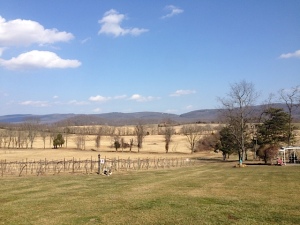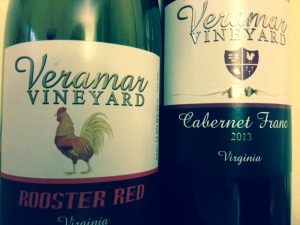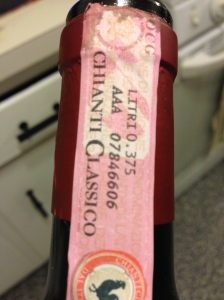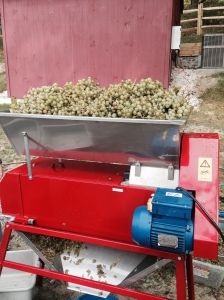
Yours truly, Mr Wining Daily at Veritage
Over my kids’ spring break in April we made our annual family trip to visit my wife’s parents in Miami. This time we also got to experience a wine and food tasting, thanks to my father-in-law who got us a pair of VIP tickets, for which we were very grateful indeed. Usually we take a few days of the week to head off on our own to places like the Everglades or the Keys or the Gulf Coast. But this year we spent the whole week in the Miami area so this made it possible to include this in our plans.
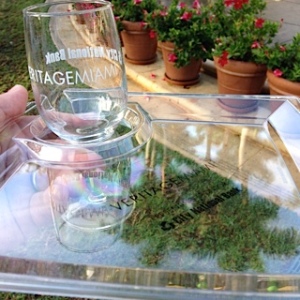
Clever serving at Veritage
The “Veritage” (formerly United Way Miami Wine & Food Festival) Fine Wine tasting was held at the Village of Merrick Park in Coral Gables, just a stone’s throw from their house. There were also some spirits there, but we did not try them as I was focused on the wine, of course! The festival also includes a legal mingle wine tasting, an interactive dinner with chefs, a craft beer tasting and an auction/wine dinner at other locations which we did not attend. So this review is just my experience at the wine tasting portion.

Yarden at Veritage
Let’s get right down to the nitty-gritty. I’m going to do most of this in list fashion so that you don’t have to read 12 pages, and let’s be honest, I was busy enjoying the experience, not taking long notes on every sip. Plus, if I had done that, I’d have missed out on a lot of the enjoyment of it. Maybe when someone is paying me to report on it I will think differently on that matter!
GREATS:

Chateau Ste. Michelle at Veritage
Food Favorites: My top tables were Buns and Buns, BLT Prime and Misha’s Cupcakes to top it off. I admit my curiosity for Buns and Buns was piqued by one attendee’s comment to another: “You’re not going to get better food than at this table.” So I waited in line and it was worth it. Amazing pork buns, and BLT had amazing brisket. And who can resist Misha’s cupcakes? We couldn’t! We even brought some home.

Great Vouvray at Veritage
Wine Favorites: I was really impressed by the Israeli wines. I know they’ve been making wine for millennia, even if most don’t think of it as a top region. The variety of grapes and styles was also impressive. Favorites were the Portuguese-style Touriga blend and the Sauvignon Blanc. Also, a few producers whose wines I work with were there, so it was a treat to taste some of their wines that were new to me. Chateau Ste Michelle from Washington were also there with two wines from their collective of wineries — Columbia Crest and Anew, representing some of their best Cabernets and Rieslings. Though their rep was MIA for most of the VIP hour, that was nothing a little self-pouring couldn’t remedy! I Also loved the ‘Boneshaker” Lodi Zinfandel, the Domaine Vincent Careme Vouvray (they had another Vouvray there with a higher profile but this one stood out as it was more more unique and complex) and the Nardi Brunello.
The Glass/Tray combo: Loved the food tray with the integrated glass holder. Both were plastic, for no-break convenience.
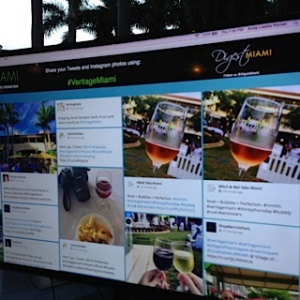
Twitter at Veritage
Social media screen: Yours truly’s tweet showed up seconds after I posted. Very interactive and 2015!
The VIP hour: A lifesaver given the capacity crowds at peak! (See follow-up comments below in ‘gripes’.)
GRIPES:
Bathrooms: Where were they? No one we asked seemed to know. While there were many restaurants in the courtyard, I doubt any or many had an open-door policy. Maybe they mentioned it to other guests at registration, but not us. We were among the earliest guests so its possible that’s why. More below on the registration desk questions.

Nightime at Veritage
Seating: More would have been appreciated. Plenty of nice restaurants here had many open tables while large crowds of guests had to negotiate the aisles with food and wine in hand, post VIP-time. This is something they need to work out, in my opinion. Perhaps work with one or two of the restaurants to provide extra seating. There were also a few spots in the park I saw off to the sides that could have fit 20+ tables for guests, but was not utilized to alleviate the crowding. When people are drinking, and eating, and especially for handicapped or older guests, this is a must. It may not be the majority of the crowd, but it should be a consideration. Park benches and edging comprised of the seating we could find.
Wine placement: I was excited to see a few of my favorite wineries on the list. Only it took me over 20 minutes to track them down, which entailed asking pourers at other tables who happened to be able to find them on a map in a piece of literature. Was this passed out at registration too? I don’t know. As a VIP, we were given passes but not the nice tote that later non-VIP guests seemed to have received, which I am guessing contained that booklet. Maybe this was also just a factor of being there precisely at the VIP hour kick-off, they weren’t entirely ready yet. I think, if you’re not ready with everything yet, don’t let guests in, even VIPs, until you are. I feel some of these details were missed for us and the other earliest arrivals.
Registration: We were dropped off at one of 3 street entrances into the mall/park area, walked past tables being set up in that corridor and looked for the registration area once inside. It took a while to find, and we had to ask. Its possible that we were supposed to come through that main building entrance, but we got dropped off by my wife’s mother on this side street to get around the car traffic. So this is possibly why it was harder to locate. There were police at this entrance but they did not redirect us to another entrance or forbid our entrance here. Perhaps they thought we were staff. But I imagine we were not alone. Seeing as there are these 3 other street (vs building) entrances, they could have posted a volunteer, or at least a sign at each indicating the direction to/location of the registration area.
All that considered, I only hope the feedback of this one attendee will help them improve a great event. I really enjoyed it and I don’t mean to sound overly critical. We have our own company tasting events and it’s nice to have others to compare it to and take away strengths and weaknesses and offer feedback that I can contribute to both, should they be interested in hearing it. And, I got to enjoy some fantastic wine and food under the palms. Plus it all goes to benefit a good cause, which I am very glad for. Cheers and thanks to Veritage 2015!









